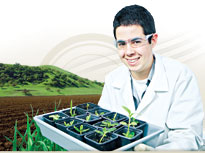Agricultural and horticultural science
Version date: 05 December 2011
Key changes: Version 1
Subject facilitator email:
seniorsecondary@tki.org.nz
What is agricultural and horticultural science about?
Agricultural and horticultural industries are key drivers of New Zealand’s economic, social, and environmental development. The products of primary production are a source of well-being for the present generation and will be so for future generations.

Horticultural science
The application of good production management practices ensures that the primary products demanded by local and world markets are made available in an ecologically and economically sustainable manner.
Through purposeful learning in agricultural and horticultural science, students engage in future and creative thinking and develop problem-solving strategies and lifelong skills. They build knowledge of practical techniques, and are encouraged to find innovative solutions to challenging production issues. They also learn to appreciate the economic, historical, social, and cultural influences on primary production and the interrelationships of science, technology, society, and the environment.
Agricultural and horticultural science adopts a practical, production-focused approach, involving students in problem solving and the use of appropriate management practices.
Programmes are based around realistic and practical contexts. Students learn to explore agricultural and horticultural issues and to communicate their ideas to others. They develop the skills of planning, investigating, designing, drawing, and model-making and capabilities in using digital tools and processes. They use creativity, logic, and knowledge to find innovative solutions to real-life problems.
In agricultural and horticultural science, students will find themselves dealing with contexts, issues, and problem solving drawn from a broad agenda that includes, for example:
- products (for example, pork, poultry, avocados, honey, timber, milk, wool, apples, grapes)
- environments (for example, waterways, erosion, landscape, soil, shelter, glasshouses, effluent, pollution; environmental modification and sustainable management practices)
- solutions for particular management issues (for example, irrigation, cropping, harvesting and milking equipment, data, information and communication digital technologies, shelter and shade construction, and cultivation technologies).
Agricultural and horticultural science guide content
Use the links below to access the sections of this guide. To navigate through the guide's web pages, select from the section and sub-section menu in the left-hand navigation.
Teaching and learning guides are produced in HTML. They have been designed to be viewed online.
To print individual pages, select the 'Print' button at the top right of each page.
To print the complete guide, select the ‘Download this guide in PDF format’ button. If your browser default is set to automatically open PDF downloads in a PDF reader, the entire guide will open and can then be printed. If not, the entire guide will download into your download folder, where you can then open the document and print.
Last updated July 30, 2015
TOP


